实验一
任务一:
代码部分:
// 现代C++标准库、算法库体验 // 本例用到以下内容: // 1. 字符串string, 动态数组容器类vector、迭代器 // 2. 算法库:反转元素次序、旋转元素 // 3. 函数模板、const引用作为形参 #include <iostream> #include <string> #include <vector> #include <algorithm> // 模板函数声明 template<typename T> void output(const T &c); void test1(); void test2(); void test3(); int main() { std::cout << "测试1: \n"; test1(); std::cout << "\n测试2: \n"; test2(); std::cout << "\n测试3: \n"; test3(); } // 输出容器对象c中的元素 template <typename T> void output(const T &c) { for(auto &i : c) std::cout << i << ' '; std::cout << '\n'; } // 测试1:组合使用算法库、迭代器、string反转字符串 void test1() { using namespace std; string s0{"0123456789"}; cout << "s0 = " << s0 << endl; string s1(s0); // 反转s1自身 reverse(s1.begin(), s1.end()); cout << "s1 = " << s1 << endl; string s2(s0.size(), ' '); // 将s0反转后结果拷贝到s2, s0自身不变 reverse_copy(s0.begin(), s0.end(), s2.begin()); cout << "s2 = " << s2 << endl; } // 测试2:组合使用算法库、迭代器、vector反转动态数组对象vector内数据 void test2() { using namespace std; vector<int> v0{2, 0, 4, 9}; cout << "v0: "; output(v0); vector<int> v1{v0}; reverse(v1.begin(), v1.end()); cout << "v1: "; output(v1); vector<int> v2{v0}; reverse_copy(v0.begin(), v0.end(), v2.begin()); cout << "v2: "; output(v2); } // 测试3:组合使用算法库、迭代器、vector实现元素旋转移位 void test3() { using namespace std; vector<int> v0{0, 1, 2, 3, 4, 5, 6, 7, 8, 9}; cout << "v0: "; output(v0); vector<int> v1{v0}; // 将[v1.begin(), v1.end())区间内元素循环左移1位 rotate(v1.begin(), v1.begin()+1, v1.end()); cout << "v1: "; output(v1); vector<int> v2{v0}; // 将[v1.begin(), v1.end())区间内元素循环左移2位 rotate(v2.begin(), v2.begin()+2, v2.end()); cout << "v2: "; output(v2); vector<int> v3{v0}; // 将[v1.begin(), v1.end())区间内元素循环右移1位 rotate(v3.begin(), v3.end()-1, v3.end()); cout << "v3: "; output(v3); vector<int> v4{v0}; // 将[v1.begin(), v1.end())区间内元素循环右移2位 rotate(v4.begin(), v4.end()-2, v4.end()); cout << "v4: "; output(v4); }
结果截图:
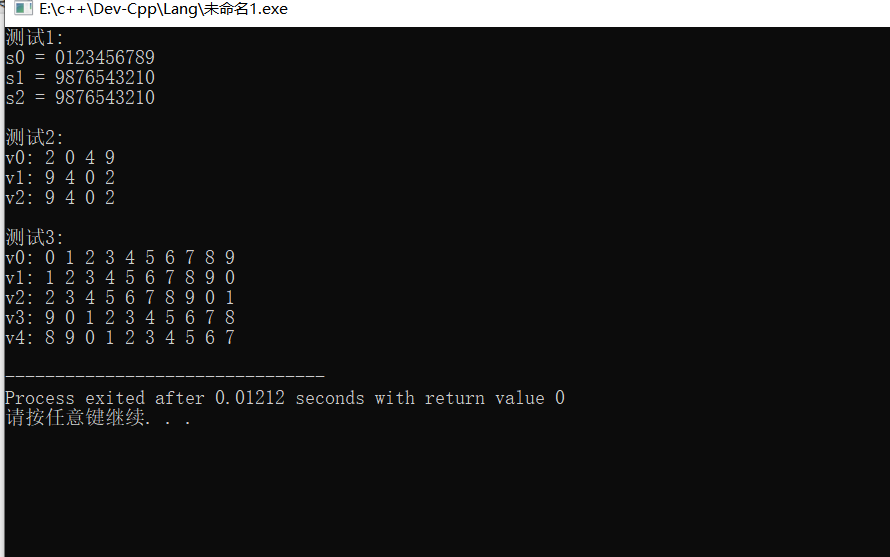
观察与思考:
1.
reverse:原地反转,直接修改原容器用法:reverse(s1.begin(), s1.end()),不需要目标容器参数;
reverse_copy:拷贝反转,原容器保持不变用法:reverse_copy(s0.begin(), s0.end(), s2.begin())需要目标容器参数,将反转结果拷贝到目标位置;
2.
rotate函数实现循环移位操作:
rotate(v1.begin(), v1.begin()+1, v1.end()):循环左移1位;
rotate(v2.begin(), v2.begin()+2, v2.end()):循环左移2位;
rotate(v3.begin(), v3.end()-1, v3.end()):循环右移1位;
rotate(v4.begin(), v4.end()-2, v4.end()):循环右移2位;
参数含义:
第一个参数:旋转范围的起始位置;
第二个参数:要移动到第一个位置的元素;
第三个参数:旋转范围的结束位置;
任务二:
代码部分:
#include <iostream> #include <vector> #include <algorithm> #include <numeric> #include <iomanip> #include <cstdlib> #include <ctime> // 模板函数声明 template<typename T> void output(const T &c); int generate_random_number(); void test1(); void test2(); int main() { std::srand(std::time(0)); // 添加随机种子 std::cout << "测试1: \n"; test1(); std::cout << "\n测试2: \n"; test2(); } // 输出容器对象c中的元素 template <typename T> void output(const T &c) { for(auto &i: c) std::cout << i << ' '; std::cout << '\n'; } // 返回[0, 100]区间内的一个随机整数 int generate_random_number() { return std::rand() % 101; } // 测试1:对容器类对象指定迭代器区间赋值、排序 void test1() { using namespace std; vector<int> v0(10); // 创建一个动态数组对象v0, 对象大小为10 generate(v0.begin(), v0.end(), generate_random_number); // 生成随机数填充v0 cout << "v0: "; output(v0); vector<int> v1{v0}; sort(v1.begin(), v1.end()); // 对整个vector排序 cout << "v1: "; output(v1); vector<int> v2{v0}; sort(v2.begin()+1, v2.end()-1); // 只对中间部分排序,不包含首尾元素 cout << "v2: "; output(v2); } // 测试2:对容器类对象指定迭代器区间赋值、计算最大值/最小值/均值 void test2() { using namespace std; vector<int> v0(10); generate(v0.begin(), v0.end(), generate_random_number); cout << "v0: "; output(v0); // 求最大值和最小值 auto min_iter = min_element(v0.begin(), v0.end()); auto max_iter = max_element(v0.begin(), v0.end()); cout << "最小值: " << *min_iter << endl; cout << "最大值: " << *max_iter << endl; // 同时求最大值和最小值 auto ans = minmax_element(v0.begin(), v0.end()); cout << "最小值: " << *(ans.first) << endl; cout << "最大值: " << *(ans.second) << endl; // 求平均值 double avg1 = accumulate(v0.begin(), v0.end(), 0.0) / v0.size(); cout << "均值: " << fixed << setprecision(2) << avg1 << endl; sort(v0.begin(), v0.end()); double avg2 = accumulate(v0.begin()+1, v0.end()-1, 0.0) / (v0.size()-2); cout << "去掉最大值、最小值之后,均值: " << avg2 << endl; }
结果截图:
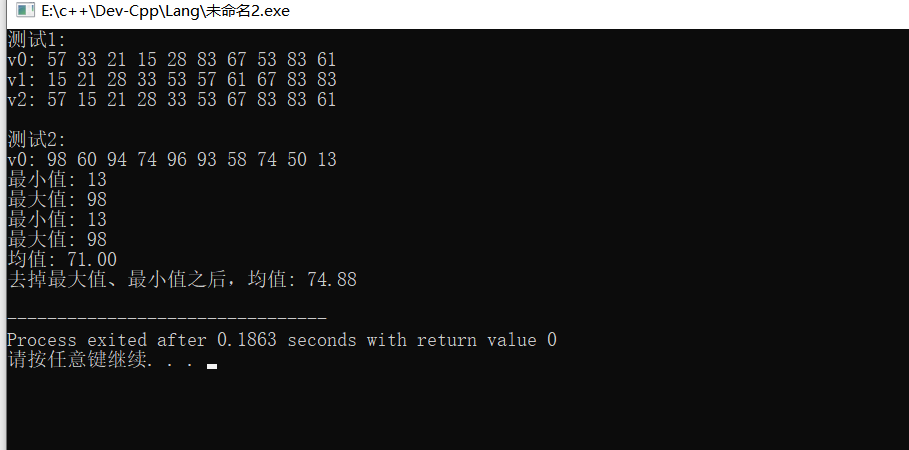
观察与思考:
1.
generate算法的作用是:使用指定的生成函数为容器的指定区间填充数据;
2.
minmax_element 只需遍历一次容器分别调用需要遍历两次容器(一次找最小,一次找最大)对于大型容器,性能提升明显;
单次调用更简洁,返回一个pair,包含两个迭代器;
在同一个遍历过程中确定最小最大值避免容器在两次调用间被修改的风险;
3.
结果截图:
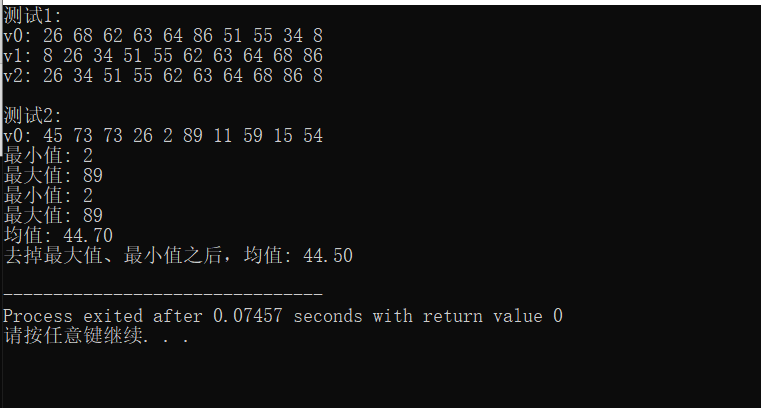
lambda表达式的的基本表达:
[捕获列表](参数列表) -> 返回类型 { 函数体 } ;
lambda表达式的优点:
代码内联:不需要单独定义函数,代码更紧凑;
避免命名污染:不需要为简单操作专门命名函数;
捕获上下文:可以方便地使用外部变量(虽然本例中没有);
开发效率:对于简单操作,编写更快;
lambda表达式的适用场景:
简单的一次性操作;
需要捕获外部变量的情况;
算法回调函数;
临时谓词函数;
任务三:
代码部分:
#include <iostream> #include <string> #include <algorithm> #include <cctype> unsigned char func(unsigned char c); void test1(); void test2(); int main() { std::cout << "测试1: 字符串大小写转换\n"; test1(); std::cout << "\n测试2: 字符变换\n"; test2(); } unsigned char func(unsigned char c) { if(c == 'z') return 'a'; if(c == 'Z') return 'A'; if(std::isalpha(c)) return static_cast<unsigned char>(c+1); return c; } void test1() { std::string s1{"Hello World 2049!"}; std::cout << "s1 = " << s1 << '\n'; std::string s2; for(auto c: s1) s2 += std::tolower(c); std::cout << "s2 = " << s2 << '\n'; std::string s3; for(auto c: s1) s3 += std::toupper(c); std::cout << "s3 = " << s3 << '\n'; } void test2() { std::string s1{"I love cosmos!"}; std::cout << "s1 = " << s1 << '\n'; std::string s2(s1.size(), ' '); std::transform(s1.begin(), s1.end(), s2.begin(), func); std::cout << "s2 = " << s2 << '\n'; }
结果截图:
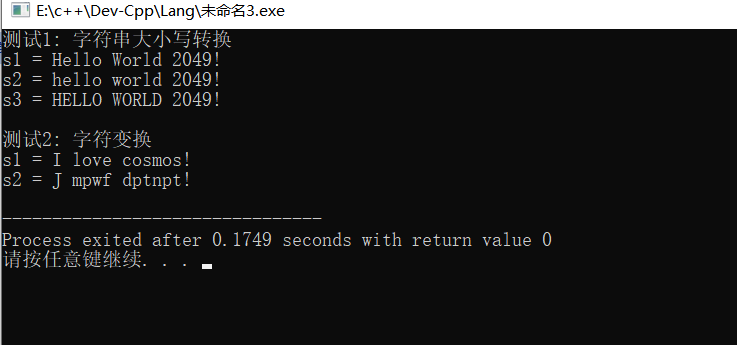
观察与思考:
1.func 函数实现了一个字符移位加密功能
将小写字母 a-y 转换为 b-z;
将小写字母 z 循环转换为 a;
将大写字母 A-Y 转换为 B-Z;
将大写字母 Z 循环转换为 A;
非字母字符(数字、空格、标点)保持不变;
2.
tolower 功能:将大写字母转换为对应的小写字母,小写字母和非字母字符保持不变;
toupper 功能:将小写字母转换为对应的大写字母,大写字母和非字母字符保持不变;
3.
参数意义:
s1.begin() - 输入字符串的起始位置;
s1.end() - 输入字符串的结束位置;
s2.begin() - 输出字符串的写入起始位置;
func - 应用于每个元素的转换函数;
区别在于是否保留原始数据,使用 s1.begin() 会破坏原始数据,虽然最后输出结果相同,但是修改过后原始数据的原始字符串也改变了;
任务四:
代码部分:
#include <iostream> #include <string> #include <algorithm> bool is_palindrome(const std::string &s); bool is_palindrome_ignore_case(const std::string &s); int main() { using namespace std; string s; // 多组输入,直到按下Ctrl+Z结束测试 while(cin >> s) { cout << boolalpha << "区分大小写: " << is_palindrome(s) << "\n" << "不区分大小写: " << is_palindrome_ignore_case(s) << "\n\n"; } } // 函数is_palindrome定义 // 待补足 bool is_palindrome(const std::string &s) { // 使用双指针法判断回文 int left = 0; int right = s.length() - 1; while (left < right) { if (s[left] != s[right]) { return false; } left++; right--; } return true; } // 函数is_palindrome_ignore_case定义 // 待补足 bool is_palindrome_ignore_case(const std::string &s) { int left = 0; int right = s.length() - 1; while (left < right) { // 转换为小写后比较 if (std::tolower(s[left]) != std::tolower(s[right])) { return false; } left++; right--; } return true; }
结果截图:

观察与思考:
要测试包含空格的字符串,可以使用getline(cin, s) 替换 cin >> s;
任务五:
代码部分:
#include <iostream> #include <string> #include <algorithm> std::string dec2n(int x, int n = 2); int main() { int x; while(std::cin >> x) { std::cout << "十进制: " << x << '\n' << "二进制: " << dec2n(x) << '\n' << "八进制: " << dec2n(x, 8) << '\n' << "十二进制: " << dec2n(x, 12) << '\n' << "十六进制: " << dec2n(x, 16) << '\n' << "三十二进制: " << dec2n(x, 32) << "\n\n"; } } // 函数dec2n定义 std::string dec2n(int x, int n) { // 处理特殊情况:x为0 if (x == 0) { return "0"; } std::string result; // 不断除以n取余数 while (x > 0) { int remainder = x % n; x = x / n; // 将余数转换为对应的字符 if (remainder < 10) { result += '0' + remainder; // 数字 0-9 } else { result += 'A' + (remainder - 10); // 字母 A-Z } } // 反转字符串,因为计算时是从低位到高位 std::reverse(result.begin(), result.end()); return result; }
结果截图:

任务六:
代码部分:
#include <iostream> #include <string> int main() { const std::string alphabet = "ABCDEFGHIJKLMNOPQRSTUVWXYZ"; // 输出原始字母表(小写,带空格) for (int i = 0; i < 26; i++) { std::cout << static_cast<char>('a' + i); if (i < 25) std::cout << " "; } std::cout << std::endl; // 生成1-26的凯撒密码移位 for (int shift = 1; shift <= 26; shift++) { // 输出数字 std::cout << shift; if (shift < 10) std::cout << " "; // 1-9的数字后面补空格对齐 // 输出移位后的字母表(大写,带空格) for (int i = 0; i < 26; i++) { std::cout << alphabet[(i + shift) % 26]; if (i < 25) std::cout << " "; } std::cout << std::endl; } return 0; }
结果截图:
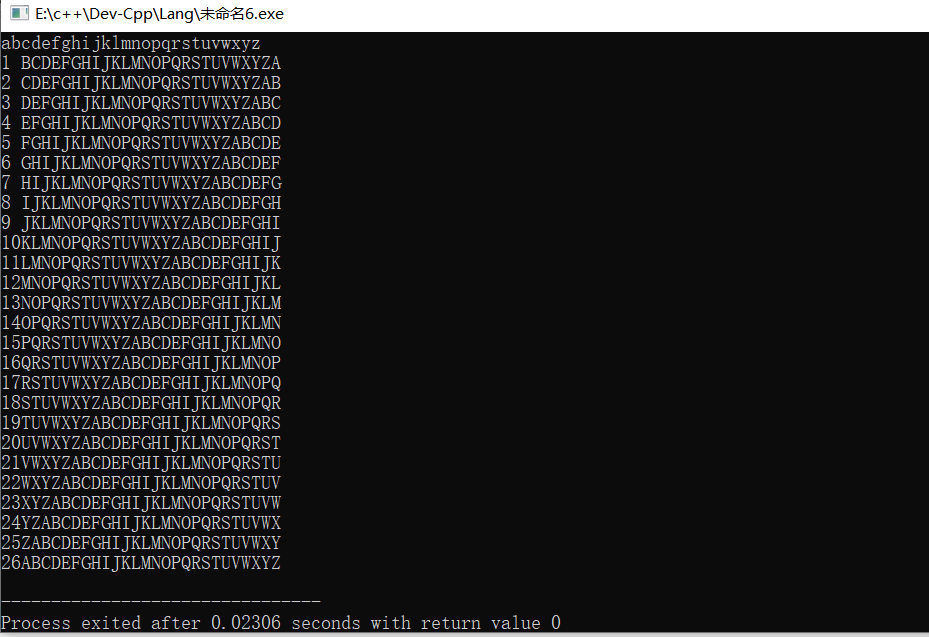
任务七:
代码部分:
#include <iostream> #include <cstdlib> #include <ctime> #include <iomanip> using namespace std; int main() { srand(time(0)); int correctCount = 0; const int totalQuestions = 10; // 生成并显示题目,获取用户答案 for (int i = 0; i < totalQuestions; i++) { int num1 = rand() % 10 + 1; int num2 = rand() % 10 + 1; int op = rand() % 4; char opChar; int correctAnswer; int userAnswer; switch (op) { case 0: // 加法 opChar = '+'; correctAnswer = num1 + num2; break; case 1: // 减法 opChar = '-'; if (num1 < num2) swap(num1, num2); correctAnswer = num1 - num2; break; case 2: // 乘法 opChar = '*'; correctAnswer = num1 * num2; break; case 3: // 除法 opChar = '/'; if (num1 % num2 != 0) { do { num2 = rand() % 9 + 1; } while (num1 % num2 != 0); } correctAnswer = num1 / num2; break; } // 输出题目并获取答案 cout << num1 << " " << opChar << " " << num2 << " = "; cin >> userAnswer; // 检查答案 if (userAnswer == correctAnswer) { correctCount++; } } cout << endl; // 计算并输出正确率 double accuracy = (static_cast<double>(correctCount) / totalQuestions) * 100; cout << fixed << setprecision(2); cout << "正确率:" << accuracy << "%" << endl; return 0; }
结果截图:
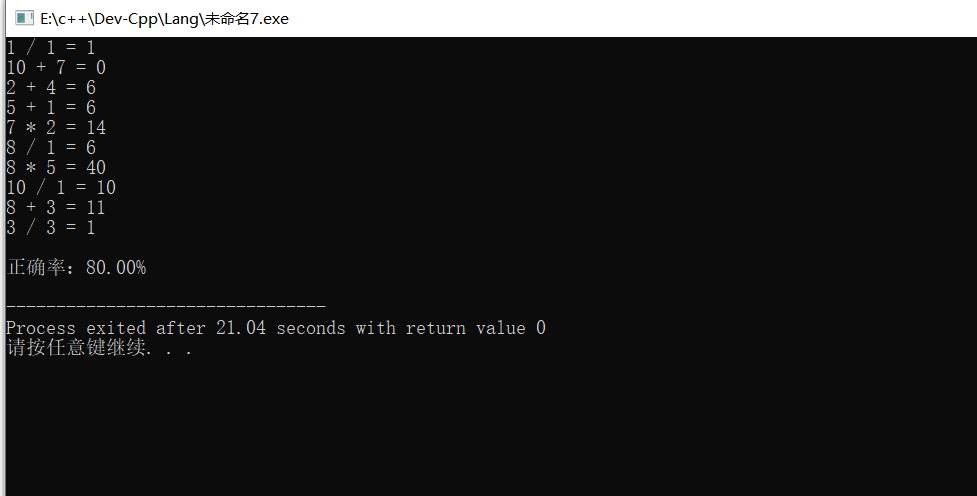





 浙公网安备 33010602011771号
浙公网安备 33010602011771号